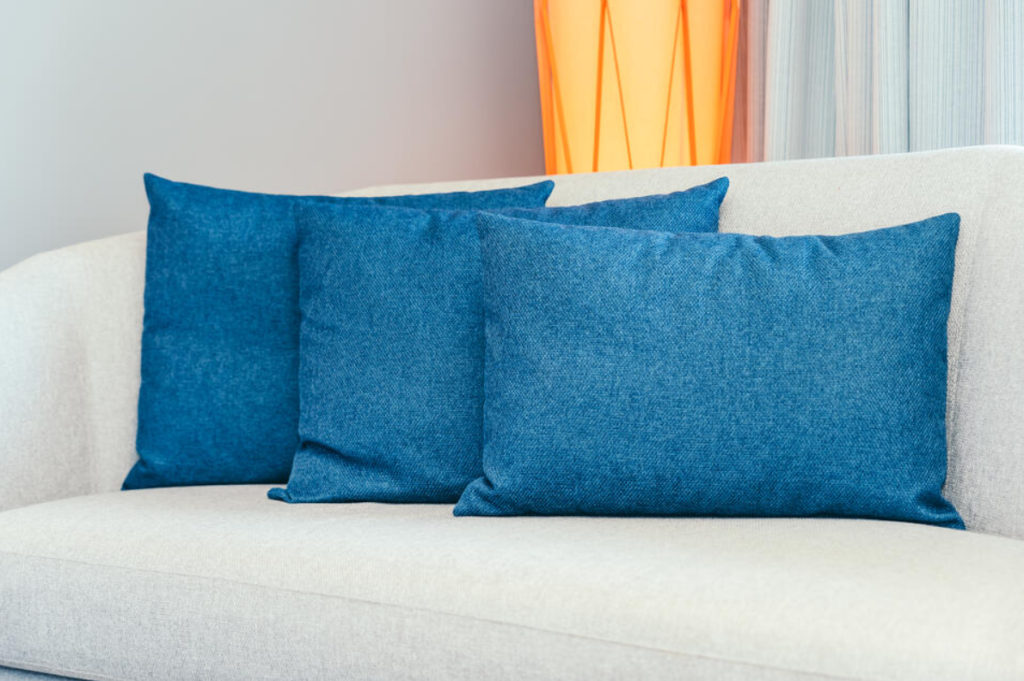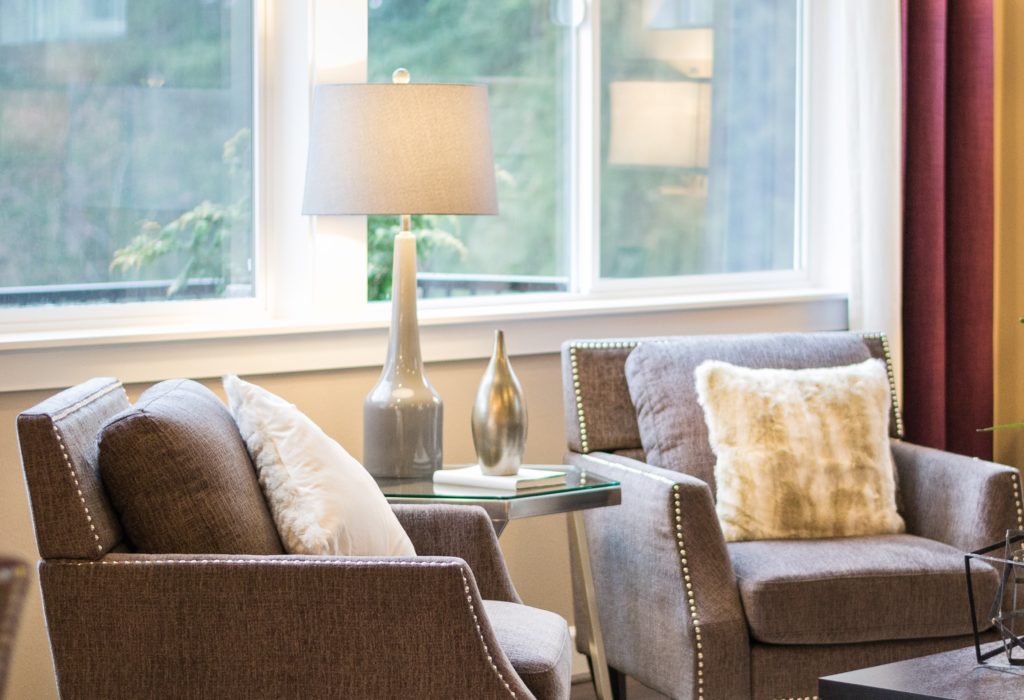When it comes to picking out furniture there are always a number of considerations to keep in mind. For example, if you’re choosing furniture for your home, you want to make sure that whatever you pick out fits the overall style and ambiance of your home. You want to make sure that it works with your floor plan and is neither oversized nor undersized relative to the room you are furnishing. If you have young children, you may want to pick something that is stain-resistant or dark enough that small spills won’t be as visible. Of course, budget will always be a factor to consider.
The same basic principles hold true when choosing furniture for senior living interiors. There are a lot of factors to consider before deciding on each piece, including aesthetics, comfort, cleanability, and especially safety.
One thing to keep in mind is that furniture plays a big role in the day-to-day comfort levels of both residents and staff members. With all of that said, an interior design team that has expertise in the senior living industry will be able to choose the best furniture options for the age, design, and activity of the community. Below are specific considerations to bear in mind when approving the selected furniture for senior living communities.
How to Select Furniture for Senior Living Interiors
Material
One of the main factors to keep in mind is the fabric and materials. There are a couple of reasons why this is important:
- Sooner or later, soiling and staining are going to happen, whether due to unsteady balance or everyday accidents. As such, it’s best to use performance-based upholstery and furniture companies that are tailor made for the aging population.
- Commercial grade furniture is also recommended. Simply put, the furniture you choose for a senior living community is where your residents and teams will congregate, so it is bound to see a lot of use. Choosing specific framing materials (ie wood, resin, or metal) will extend the lifespan of your furnishings.
Colors
Colors are also important.. You will want to select furnishings that enhance the aesthetics of your senior living community, but even more importantly, choose furniture colors that impact resident experience positively. This could include “conversation pieces” like furnishings that spark conversation.
Additionally, it is important to align with an industry specific interior designer to ensure that furniture recommendations are chosen to minimize trip hazards and other navigational barriers. If your community serves memory care residents, it’s important to consider patterns and textures in furniture designs which include colors and patterns that stimulate residents impacted by dementia.
Finally, keep in mind that bright, cheerful colors can be helpful for lifting spirits and keeping residents and employees alike in a happier frame of mind.

Functionality
In senior living communities, you should expect that residents will often lean on furniture to assist with everyday movements. For example, residents may depend on furniture to support them while they stand or walk. They may also grip furniture to help them get their balance as they stand up or sit down.
It’s important that the furniture you select is strong enough to support a person’s body weight without wobbling or collapsing. For similar reasons, it’s wise to avoid glass surfaces or anything with sharp, pointy edges.
Finally, remember that standard-sized chairs and loveseats tend to work better than sofas as they ensure that everyone who sits down has easy access to at least one armrest.
Shape and Height
Shape and height of your furnishings can also have a big impact on resident wellbeing.
We mentioned the importance of avoiding pointy edges. We’ll go a step further and recommend round-shaped furniture whenever possible. If you do select something rectangular, such as a long dining room table, opt for something with rounded corners.
When selecting chairs, be mindful of the chair’s height. Your interior designer will avoid recommending chairs that are too low or too deep that create difficulty to maneuver and get out of. Conversely, when choosing loveseats and lounge chairs, don’t choose anything that’s too soft or loose with cushioning. Ease of use should always be of foremost concern.
Tripping Hazards
Any time you are choosing furniture for a senior living community, no matter the age or acuity level, tripping hazards should be on your radar. It’s important to avoid bringing anything into the building that could cause a resident to stumble or injure themselves.
Some of the most common culprits include loose rugs, small scale side tables that are tippy, furniture that may have legs that angle backwards, and low light levels. Be mindful of these and other potential tripping hazards at all stages of the interior design process.
Health Guidelines
Believe it or not, there are types of materials you can use to furnish your senior living interiors that help with cleanability and infection control. Your interior designer has resources to materials that can comply with regulations related to the prevention of Hospital Acquired Infections (HAIs).
In higher acute care, such as skilled nursing environments, it’s important to select materials and furniture that mitigate microbial growth. High-impact polymers are often the best bets, but there are plenty of materials that you can choose from.
It may be wise to enlist the expertise of a senior living interior design company, like Eight Twenty 8 Design.
Movement
It’s in the best interest of your residents to live out an active daily lifestyle. You can encourage this movement with your furniture selections. Some examples of how to do this include:
- Furnishings that are lightweight and/or have casters and glides on appropriate flooring materials, help residents who move furniture around independently.
- In common areas, especially dining areas and activity rooms, choosing furnishings that are flexible in arrangement for staff and families to accommodate different events and lifestyle living.

Natural Lighting
A simple point, perhaps, but still worth registering: One of the best things you can do to support the mental health of your residents (as well as your staff and team members) is to allow plenty of natural light into the building.
As you select furnishings that will be up against large window and take a lot of daylighting, it
It Is important to select materials that will not fade or deteriorate over time. Your interior designer has specific vendors that have materials rated for UV and high performance protection in these types of environments. Other considerations are glare and sun control. When selecting window shades or coverings, consider the opacity levels in your space to achieve the proper visibility and temperature control.
Personality
Last but not least, choose furniture that has a pop of color, and brings personality to the building.
There is really nothing more discouraging than a community that feels drab, dark, or dingy. This is bad for residents, staff morale, and for attracting new families.
Make sure you select furniture that injects a bit of fun and vibrancy to your senior living interiors. Again, one of the best ways you can explore the different options and select the right pieces is to enlist the guidance of a senior living interior design company.
Using Furniture to Revitalize Your Senior Living Community
To conclude, it’s worth noting that furniture selection isn’t just a consideration for brand new senior living communities. It’s also something to think about when you’re looking for a way to spruce up or rejuvenate your current senior living community. If you need to modernize or liven up the place but don’t have the budget for a full remodel, simply bringing in some new furniture can go a long way.
As you consider different furniture options for your senior living community, there are clearly a number of factors to juggle. To help you balance all of these concerns and make smart decisions about your senior living interiors, we invite you to contact us. Eight Twenty 8 Design has a proven track record offering turnkey solutions for senior living communities. Reach out to us to discuss furniture selection or any other interior design needs.

